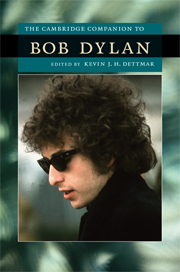Book contents
- Frontmatter
- Introduction
- Part I Perspectives
- Part II Landmark Albums
- 10 The Freewheelin’ Bob Dylan (1963)
- 11 Bringing It All Back Home (1965)
- 12 Highway 61 Revisited (1965)
- 13 Blonde on Blonde (1966)
- 14 The Basement Tapes (1967; 1975)
- 15 Blood on the Tracks (1975)
- 16 Infidels (1983)
- 17 “Love and Theft” (2001)
- Works cited
- Index
16 - Infidels (1983)
from Part II - Landmark Albums
Published online by Cambridge University Press: 28 May 2009
- Frontmatter
- Introduction
- Part I Perspectives
- Part II Landmark Albums
- 10 The Freewheelin’ Bob Dylan (1963)
- 11 Bringing It All Back Home (1965)
- 12 Highway 61 Revisited (1965)
- 13 Blonde on Blonde (1966)
- 14 The Basement Tapes (1967; 1975)
- 15 Blood on the Tracks (1975)
- 16 Infidels (1983)
- 17 “Love and Theft” (2001)
- Works cited
- Index
Summary
To consider Infidels is to wade into the perplexity of Bob Dylan's 1980s, generally viewed as his lost decade, or at the very least an era for Dylan of intermittent lost faith in his relationships both to his audience and to his working methodology (such as it was). The Infidels recordings appear a focused attempt at statement-making by an artist who had lately been in a losing argument with his audience, if not himself, over the value of devotional biblical study to his art; the record has the mixed fate of seeming one of his most deliberate, and most wrecked. (If it is too much to claim it as Dylan's equivalent to Orson Welles's The Magnificent Ambersons, perhaps it may qualify as his Lady from Shanghai.) Musically, Dylan's purpose was expressed by the assembling of an unusual and fluent studio band, some of them strangers to one another before the work began (Dire Straits's keyboardist Alan Clark and guitarist-auteur, Mark Knopfler, who also participated in the record's production; Rolling Stone Mick Taylor, and the Jamaican rhythm-section-for-hire, Sly Dunbar and Robbie Shakespeare), rather than the use of a received group or of Dylan's current touring unit. Yet by the evidence of “bootlegs” both officially sanctioned and not, the set of songs released as Infidels in 1983 was only an iceberg's-tip exposure of the power, charm, and persuasiveness of the material recorded with this band. A devotee is forced to conclude, despite any reservations against psychobiography, or even simple second-guessing of a genius's purposes, that in 1983 Bob Dylan's art was vulnerable to a rather savage ambivalence on the part of its maker.
- Type
- Chapter
- Information
- The Cambridge Companion to Bob Dylan , pp. 160 - 166Publisher: Cambridge University PressPrint publication year: 2009



